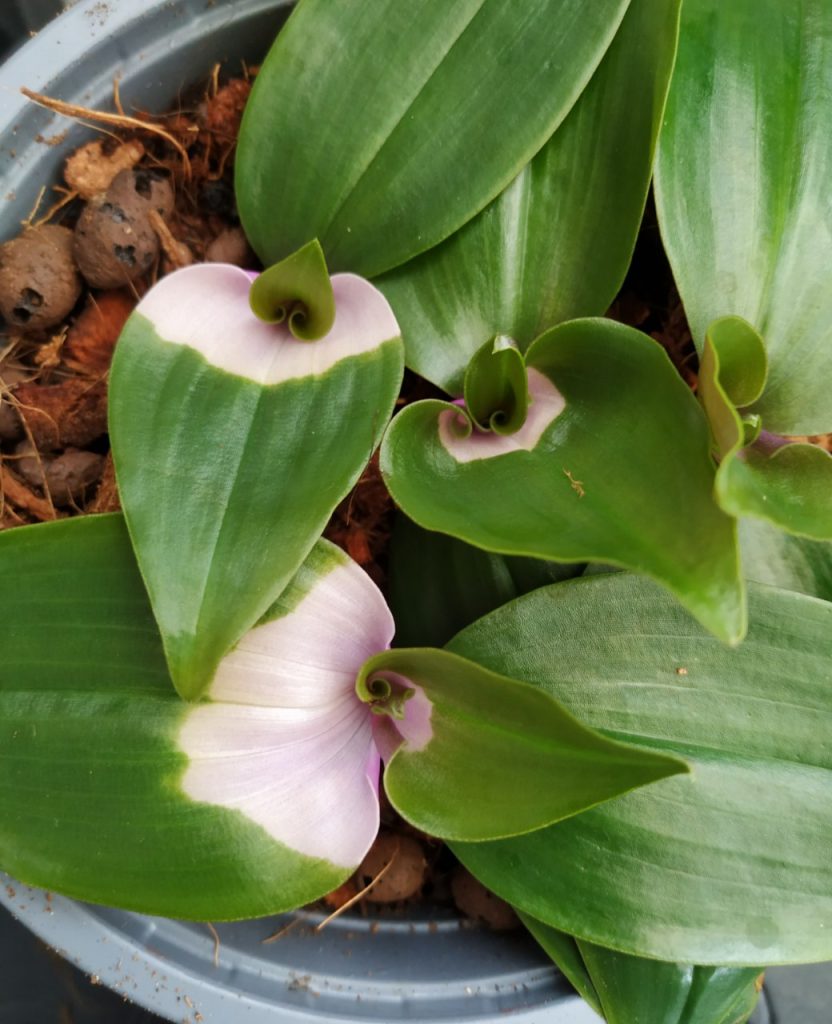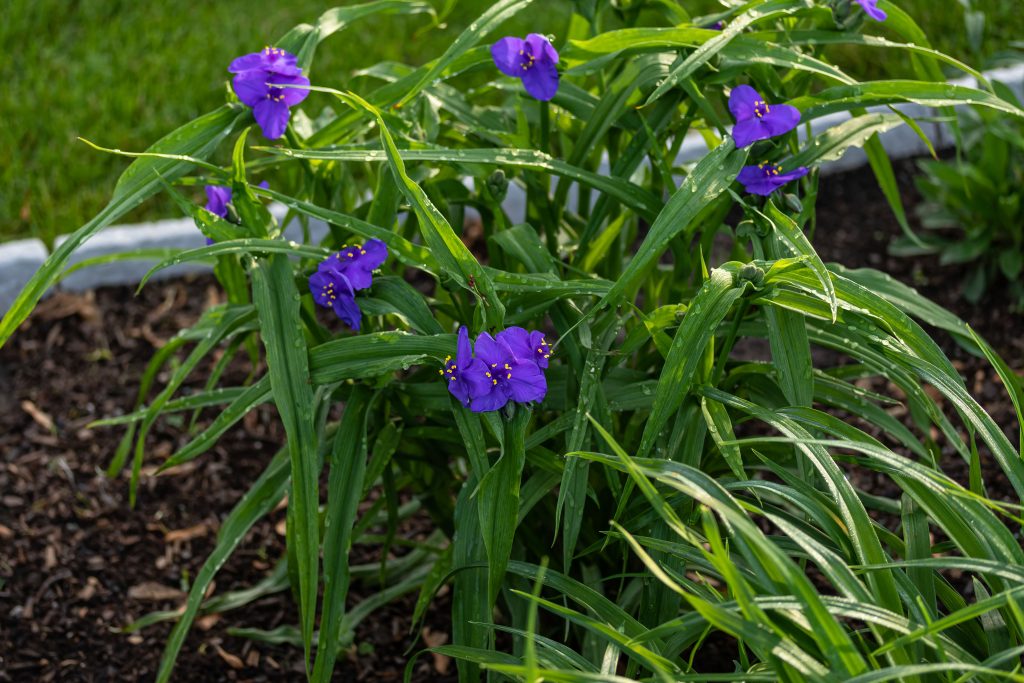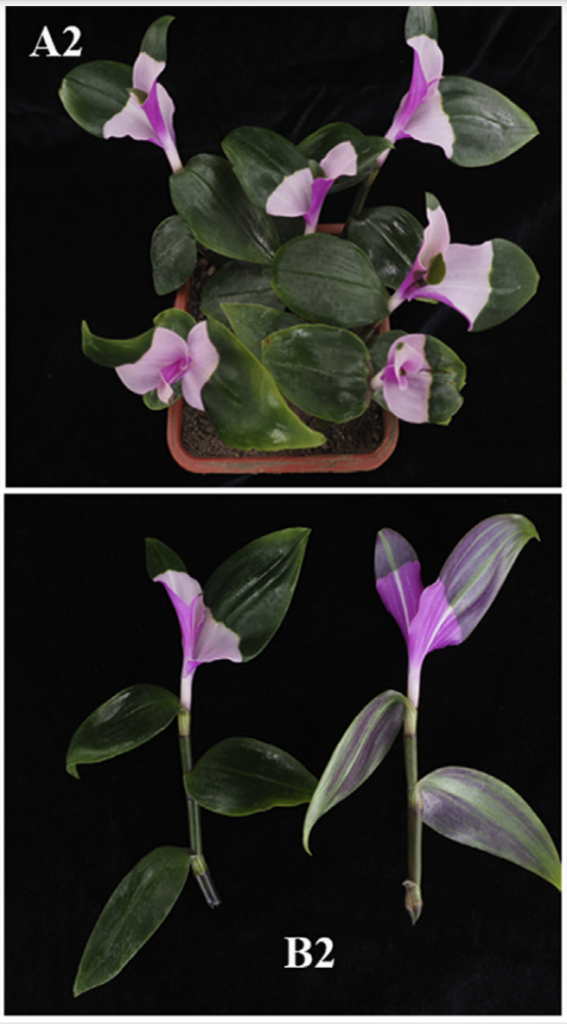[Edited with new information, 8th May 2022]
Skip to: T. (Andersoniana Group) ‘Blushing Bride’ // T. ‘Maiden’s Blush’ // Conclusion // References
There’s a popular tradescantia cultivar, a sprawling creeper with an unusual pattern of variegation. In warm temperatures, the plant is uniformly dark green. But in cooler temperatures, new growth develops with sharply-defined patches of pink on the bottom half or centre of each leaf.

Sometimes this plant is labelled as Tradescantia (Andersoniana Group) ‘Blushing Bride’ or Tradescantia × andersoniana ‘Blushing Bride’, and sometimes it’s labelled as Tradescantia fluminensis ‘Maiden’s Blush’. But these names actually refer to two completely different cultivars, with a lot of confusion in their history! The correct name for this variegated plant is simply Tradescantia ‘Maiden’s Blush’. So what’s with the other name? And why no species? Let’s dive into the research.
Tradescantia (Andersoniana Group) ‘Blushing Bride’
Contrary to popular use, this is not another name for the common pink-variegated cultivar. In fact it’s a completely different plant, but it’s older, and has mostly disappeared from cultivation.
The T. Andersoniana Group are frost-hardy, deciduous, herbaceous perennials. They’re commonly grown in gardens for their flowers, and form mounds of long grass-like leaves. If you mostly grow tropical tradescantias as houseplants, they might look completely unfamiliar! Here’s an example:

The origins of the true ‘Blushing Bride’ cultivar are hard to track down – because most mentions of ‘Blushing Bride’ today are actually referring to something else!
But I managed to get the details from Kevin Vaughn, who actually created the original hybrid. It grew from seeds from the cultivar ‘Pauline’ and an unknown pollen parent, and had clear pink flowers with very rounded petals. The exact date is uncertain, but it was selected some time between 1990 and 1996. At that time it was distributed by T&Z nurseries, Busse nursery, and probably others.
I dug up this Russian website from 2006 which contains one single photo of the bloom. But I haven’t been able to find a catalog or hardcopy publication that describes the cultivar yet, or any sign that it’s still in distribution any more recently than that. (Do you have sources? Let me know!).
Tradescantia ‘Maiden’s Blush’
This is the correct name for the popular pink-variegated cultivar. It grows long creeping or semi-upright stems with pointed-oval leaves. In cool temperatures, the leaves develop strange splashes of pink or white. The history and species identity of this plant is uncertain, and there is a confusing trail of clues which point in many different directions at once. I’ll follow them backwards in time…
One of the popular stories about the plant today is that the variegation is caused by a virus which becomes dormant in warm weather. But is that true?
| Claim | Truth | |
|---|---|---|
| The variegation of ‘Maiden’s Blush’ is caused by a virus | There is no evidence the plant has a virus, and there is some evidence that it’s caused by a genetic mutation |
Not at all. When I heard the virus story, I started searching to find out where it came from – surely there would be some interesting scientific research which isolated and identified this weird virus? But there isn’t. The virus story seems to have been made up from nowhere, and simply spread because it sounds interesting.
In the course of my searching, I did find some very interesting research about a tradescantia with temperature-dependent variegation (He et al, 2011; Liu et al., 2016; Liu et al., 2021).
The research describes how, in around 2007, the scientists irradiated live T. fluminensis stems with a carbon ion beam, and then grew them on for 7 months to see what happened. By that time, one of the plants was showing the characteristic temperature-changing variegated pattern, shown in photos.

The paper doesn’t state that the plant they mutated entered cultivation or became known as ‘Maiden’s Blush’, but the mutation looks identical and very distinctive.
It looked like this would be the end of the story – the plant is a genetic mutation of T. fluminensis, created around 2007 in China.
But the mystery goes deeper. While I was looking at other tradescantia specimens from the RHS Wisley herbarium, I came across a sheet from 1992 which shows the familiar variegated plant, this time identified as T. crassula ‘Maiden Blush’ (“Tradescantia crassula”, 1992). From almost 20 years before the researchers supposedly created it!
I can only think of two possible explanations for this situation.
- The research contains false information. Either the researchers didn’t create the plant at all, or they created it much earlier than they describe. This would be a very serious accusation, and not one that anyone should make lightly! I can’t see any reason why the researchers would have been motivated to do this, and there’s certainly nothing in the research that suggests foul play.
- The same plant somehow arose in multiple separate events, once pre-1992 (apparently in the UK), and again during the 2007 research at the Chinese Academy of Sciences. The odds of an identical complex mutation arising multiple times are absolutely astronomical.
Both of these potential explanations seem almost impossible! And yet, it seems that at least one of them must be the case.
The solution to this mystery won’t actually change the correct name for the cultivar itself. Although the herbarium specimen uses the spelling ‘Maiden Blush’, the form ‘Maiden’s Blush’ has become universally more common and so should be accepted as correct. And the invalid name ‘Blushing Bride’ is easily ruled out, because it was created much later and referred to a different plant.
The exact species of the cultivar is questionable. It’s easy to dismiss T. Andersoniana Group as an obvious mistake due to naming confusion. But is it T. fluminensis or T. crassula? The scientists who researched the genetic mutation say T. fluminensis, but then it’s possible the plant they researched wasn’t actually ‘Maiden’s Blush’ at all! The oldest source so far says T. crassula, even though it’s never sold with that name today. The two species are closely related and can be difficult to distinguish, and it’s even quite possible the plant could be a hybrid.
With all this uncertainty, it’s safest to avoid labelling it as any particular species – just Tradescantia ‘Maiden’s Blush’. Maybe one day, there’ll be some more definitive research to confirm the species or hybrid origin of the plant. But for now we can only call it a mystery.
Do you have any more information or evidence to add to this puzzle? Please share!
What triggers the variegation?
There’s no precise answer to this question.
We know that it’s not about light level. In bright light the pale parts will be pink, and in lower light they’ll be white, cream, or yellowish. But the albino patches themselves don’t appear or disappear according to lighting.
And based on lots of anecdotal evidence (the best thing we’ve got so far), it seems to be related to temperature. It’s not clear whether this is about the average temperature overall, about the maximum or minimum temperature, or something to do with the variation between day and night. It could be a combination of several factors.
My personal experience is that my indoor plants which live at 20-24C, 24/7 and year round never develop the pink at all. And my outdoor plants which spend UK spring, summer, and autumn at 10-30C (with more day/night variation) stay consistently pink the whole time they’re out. Others have reporteed success from keeping the plant in a cool room, on a drafty windowsil, or next to an air conditioning vent. Start experimenting!
Conclusion
So, the pink-variegated creeper might be T. fluminensis, or T. crassula, or maybe something else. But it’s definitely not the same as T. (Andersoniana Group) ‘Blushing Bride’, according to the breeder who made that. I’m not sure how or why the older name became applied to the newer plant. There are still some mysteries in its history and origins, but this is the best answer we have for now.
The correct name is Tradescantia ‘Maiden’s Blush’. Spread the word!
Found this article helpful?
If you want more great resources like this, you can help me keep making them with a regular payment on Patreon.
References
“Tradescantia crassula”. (1992). Herbarium specimen. RHS Wisley Herbarium, Barcode WSY0064425. http://rhs.org.uk/xxxxx/WSY0064425
He, J., Lu, D., Yu, L., & Li, W.(2011) Pigment analysis of a color-leaf mutant in Wandering Jew (Tradescantia fluminensis) irradiated by carbon ions. Nuclear Science and Techniques, 22(2), 77-83. doi:10.13538/j.1001-8042/nst.22.77-83. Open access link.
Liu, R., Dong, X., Gu, W., Yu, L., Jin, W., Qu, Y., Zhang, F., & Li, W. (2016). Variation in the phenotypic features and transcripts of thermo-sensitive leaf-color mutant induced by carbon ion beam in Green wandering jew (Tradescantia fluminensis). Scientia Horticulturae, 213, 303-313. doi:10.1016/j.scienta.2016.11.001. Open access link.
Liu, R., Dong, X., Zhang, M., Qu, Y., Jin, W., Li, X., Zhou, L., Yu, L., & Li, W. (2021). Comparative transcriptome analysis reveals candidate genes for leaf color formation in a thermo-sensitive leaf-color mutant generated by carbon-ion beam in green wandering Jew (Tradescantia fluminensis). Scientia Horticulturae, 288, article 110300. doi:10.1016/j.scienta.2021.110300. Open access link.


2 replies on “‘Blushing Bride’ and ‘Maiden’s Blush’ – what’s the difference?”
This is an excellent article Many Thanks for sharing
Brilliant detective work Avery! This has bugged me for ages so although I’ll promptly forget all the intricate details – I’ll remember the main gist of it that it’s Maiden’s Blush and not Bushing Bride. Well done on researching and writing such an excellent piece.